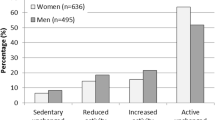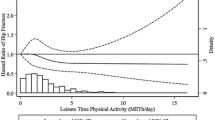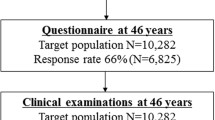Abstract
Summary
This study assessed the effects of physical activity on a 10-year incidence of self-reported vertebral fractures in adult women of a large Japanese cohort. Medium levels of strenuous activity and long-duration sedentary activity were associated with a lower incidence of vertebral fractures; association patterns appear to be different from hip fractures.
Introduction
Physical activity helps prevent hip fracture, but little is known about the longitudinal association between physical activity and vertebral fractures. The purpose of this study was to evaluate the effects of physical activity on the 10-year incidence of symptomatic vertebral fractures using data from the Japan Public Health Center-based Prospective Study.
Methods
Baseline studies were conducted in 1993–1994, and the follow-up study was conducted 10 years later. We analyzed 23,757 women aged 40–69 years. At baseline, physical activity was assessed as a predictor by using a questionnaire. Subjects were asked to report vertebral fractures that occurred during the 10-year follow-up period. Relative risks (RRs) adjusted for confounders were estimated by multiple logistic regression analysis.
Results
The 10-year cumulative incidence of vertebral fractures was 0.67 %. Those who engaged in strenuous physical activity of <1 h/day had a significantly lower incidence of vertebral fractures than those who did not engage in such activity (RR = 0.52, 95 % CI 0.28–0.97), while those engaged in such activity ≥1 h/day did not (RR = 0.82, 95 % CI 0.58–1.14). Long-duration sedentary activity was associated with a low incidence of vertebral fractures (P for trend = 0.0002), but the frequencies of sports activities and metabolic equivalents were not (P for trend = 0.0729 and 0.4341, respectively).
Conclusions
Strenuous activity and sedentary activity are associated with the incidence of vertebral fractures, although the association may not be linear. The pattern of association between physical activity and vertebral fractures appears to be different from that of hip fractures.
Similar content being viewed by others
References
Marcus R, Majumder S (2001) The nature of osteoporosis. In: Marcus R, Feldman D, Kelsey J (eds) Osteoporosis, 2nd edn. Academic, San Diego, pp 3–17
Schmitt NM, Schmitt J, Dören M (2009) The role of physical activity in the prevention of osteoporosis in postmenopausal women—an update. Maturitas 63:34–38
Hashimoto T, Sakata K, Yoshimura N (1997) Epidemiology of osteoporosis in Japan. Osteoporos Int 7(Suppl 3):S99–S102
Ross PD, Fujiwara S, Huang C et al (1995) Vertebral fracture prevalence in women in Hiroshima compared to Caucasians or Japanese in the US. Int J Epidemiol 24:1171–1177
Greendale GA, Barrett-Connor E (2001) Outcomes of osteoporotic fractures. In: Marcus R, Feldman D, Kelsey J (eds) Osteoporosis, 2nd edn. Academic, San Diego, pp 819–829
Moayyeri A (2008) The association between physical activity and osteoporotic fractures: a review of the evidence and implications for future research. Ann Epidemiol 18:827–835
Tsugane S, Sobue T (2001) Baseline survey of JPHC study: design and participation rate. Japan Public Health Center-based Prospective Study on Cancer and Cardiovascular Diseases. J Epidemiol 11(Suppl 6):S24–S29
Nakamura K, Inoue M, Kaneko Y, Tsugane S, for the Japan Public Health Center-Based Prospective Study Group (2011) Positive predictive values for self-reported fractures in an adult Japanese population. Environ Health Prev Med 16:129–132
Ainsworth BE, Bassett DR Jr, Strath SJ et al (2000) Comparison of three methods for measuring the time spent in physical activity. Med Sci Sports Exerc 32(Suppl 9):S457–S464
Inoue M, Yamamoto S, Kurahashi N, Iwasaki M, Sasazuki S, Tsugane S, Japan Public Health Center-based Prospective Study Group (2008) Daily total physical activity level and total cancer risk in men and women: results from a large-scale population-based cohort study in Japan. Am J Epidemiol 168:391–403
Qu X, Zhang X, Zhai Z et al (2014) Association between physical activity and risk of fracture. J Bone Miner Res 29:202–211
Gregg EW, Cauley JA, Seeley DG, Ensrud KE, Bauer DC (1998) Physical activity and osteoporotic fracture risk in older women. Study of Osteoporotic Fractures Research Group. Ann Intern Med 129:81–88
Roy DK, O’Neill TW, Finn JD et al (2003) Determinants of incident vertebral fracture in men and women: results from the European Prospective Osteoporosis Study (EPOS). Osteoporos Int 14:19–26
Nevitt MC, Cummings SR, Stone KL et al (2005) Risk factors for a first-incident radiographic vertebral fracture in women > or = 65 years of age: the study of osteoporotic fractures. J Bone Miner Res 20:131–140
Samelson EJ, Hannan MT, Zhang Y, Genant HK, Felson DT, Kiel DP (2006) Incidence and risk factors for vertebral fracture in women and men: 25-year follow-up results from the population-based Framingham study. J Bone Miner Res 21:1207–1214
Garland DE, Stewart CA, Adkins RH et al (1992) Osteoporosis after spinal cord injury. J Orthop Res 10:371–378
Tremblay MS, Colley RC, Saunders TJ, Healy GN, Owen N (2010) Physiological and health implications of a sedentary lifestyle. Appl Physiol Nutr Metab 35:725–740
Sofi F, Capalbo A, Cesari F, Abbate R, Gensini GF (2008) Physical activity during leisure time and primary prevention of coronary heart disease: an updated meta-analysis of cohort studies. Eur J Cardiovasc Prev Rehabil 5:247–257
Strath SJ, Kaminsky LA, Ainsworth BE et al (2013) Guide to the assessment of physical activity: clinical and research applications: a scientific statement from the American Heart Association. Circulation 128:2259–2279
Acknowledgments
We thank all staff members in each study area and in the central offices for their cooperation and technical assistance. This study was supported by the National Cancer Center Research and Development Fund (23-A31[toku]) (since 2011) and a Grant-in-Aid for Cancer Research (from 1989 to 2010). The members of the Japan Public Health Center-based Prospective Study Group are shown in Appendix.
Conflicts of interest
Manami Inoue is the beneficiary of a financial contribution from the AXA Research fund as chair holder of the AXA Department of Health and Human Security, Graduate School of Medicine, The University of Tokyo. The AXA Research Fund had no role in the design, data collection, analysis, interpretation or manuscript drafting, or in the decision to submit the manuscript for publication. Kazutoshi Nakamura, Kaori Kitamura, Norie Sawada, and Shoichiro Tsugane declare that they have no conflict of interest.
Author information
Authors and Affiliations
Consortia
Corresponding author
Appendix
Appendix
The members of the Japan Public Health Center-based Prospective Study (JPHC Study, principal investigator: S. Tsugane) Group are the following: S. Tsugane, S. Sasazuki, M. Iwasaki, N. Sawada, T. Shimazu, T. Yamaji, and T. Hanaoka, National Cancer Center, Tokyo; J. Ogata, S. Baba, T. Mannami, A. Okayama, and Y. Kokubo, National Cerebral and Cardiovascular Center, Osaka; K. Miyakawa, F. Saito, A. Koizumi, Y. Sano, I. Hashimoto, T. Ikuta, Y. Tanaba, H. Sato, and Y. Roppongi, Iwate Prefectural Ninohe Public Health Center, Iwate; Y. Miyajima, N. Suzuki, S. Nagasawa, Y. Furusugi, N. Nagai, Y. Ito, and S. Komatsu, Akita Prefectural Yokote Public Health Center, Akita; H. Sanada, Y. Hatayama, F. Kobayashi, H. Uchino, Y. Shirai, T. Kondo, R. Sasaki, Y. Watanabe, Y. Miyagawa, Y. Kobayashi, M. Machida, K. Kobayashi, and M. Tsukada, Nagano Prefectural Saku Public Health Center, Nagano; Y. Kishimoto, E. Takara, T. Fukuyama, M. Kinjo, M. Irei, and H. Sakiyama, Okinawa Prefectural Chubu Public Health Center, Okinawa; K. Imoto, H. Yazawa, T. Seo, A. Seiko, F. Ito, F. Shoji, and R. Saito, Katsushika Public Health Center, Tokyo; A. Murata, K. Minato, K. Motegi, T. Fujieda, and S. Yamato, Ibaraki Prefectural Mito Public Health Center, Ibaraki; K. Matsui, T. Abe, M. Katagiri, M. Suzuki, and K. Matsui, Niigata Prefectural Kashiwazaki and Nagaoka Public Health Center, Niigata; M. Doi, A. Terao, Y. Ishikawa, and T. Tagami, Kochi Prefectural Chuo-higashi Public Health Center, Kochi; H. Sueta, H. Doi, M. Urata, N. Okamoto, and F. Ide and H. Goto, Nagasaki Prefectural Kamigoto Public Health Center, Nagasaki; H. Sakiyama, N. Onga, H. Takaesu, M. Uehara, and T. Nakasone, Okinawa Prefectural Miyako Public Health Center, Okinawa; F. Horii, I. Asano, H. Yamaguchi, K. Aoki, S. Maruyama, M. Ichii, and M. Takano, Osaka Prefectural Suita Public Health Center, Osaka; Y. Tsubono, Tohoku University, Miyagi; K. Suzuki, Research Institute for Brain and Blood Vessels Akita, Akita; Y. Honda, K. Yamagishi, S. Sakurai and N. Tsuchiya, University of Tsukuba, Ibaraki; M. Kabuto, National Institute for Environmental Studies, Ibaraki; M. Yamaguchi, Y. Matsumura, S. Sasaki, and S. Watanabe, National Institute of Health and Nutrition, Tokyo; M. Akabane, Tokyo University of Agriculture, Tokyo; T. Kadowaki and M. Inoue, The University of Tokyo, Tokyo; M. Noda and T. Mizoue, National Center for Global Health and Medicine, Tokyo; Y. Kawaguchi, Tokyo Medical and Dental University, Tokyo; Y. Takashima and Y. Yoshida, Kyorin University, Tokyo; K. Nakamura, Niigata University, Niigata; S. Matsushima and S. Natsukawa, Saku General Hospital, Nagano; H. Shimizu, Sakihae Institute, Gifu; H. Sugimura, Hamamatsu University School of Medicine, Shizuoka; S. Tominaga, Aichi Cancer Center, Aichi; N. Hamajima, Nagoya University, Aichi; H. Iso and T. Sobue, Osaka University, Osaka; M. Iida, W. Ajiki, and A. Ioka, Osaka Medical Center for Cancer and Cardiovascular Disease, Osaka; S. Sato, Chiba Prefectural Institute of Public Health, Chiba; E. Maruyama, Kobe University, Hyogo; M. Konishi, K. Okada, and I. Saito, Ehime University, Ehime; N. Yasuda, Kochi University, Kochi; S. Kono, Kyushu University, Fukuoka; S. Akiba, Kagoshima University, Kagoshima.
Rights and permissions
About this article
Cite this article
Nakamura, K., Kitamura, K., Inoue, M. et al. Physical activity and 10-year incidence of self-reported vertebral fractures in Japanese women: The Japan Public Health Center-based Prospective Study. Osteoporos Int 25, 2565–2571 (2014). https://doi.org/10.1007/s00198-014-2770-x
Received:
Accepted:
Published:
Issue Date:
DOI: https://doi.org/10.1007/s00198-014-2770-x




